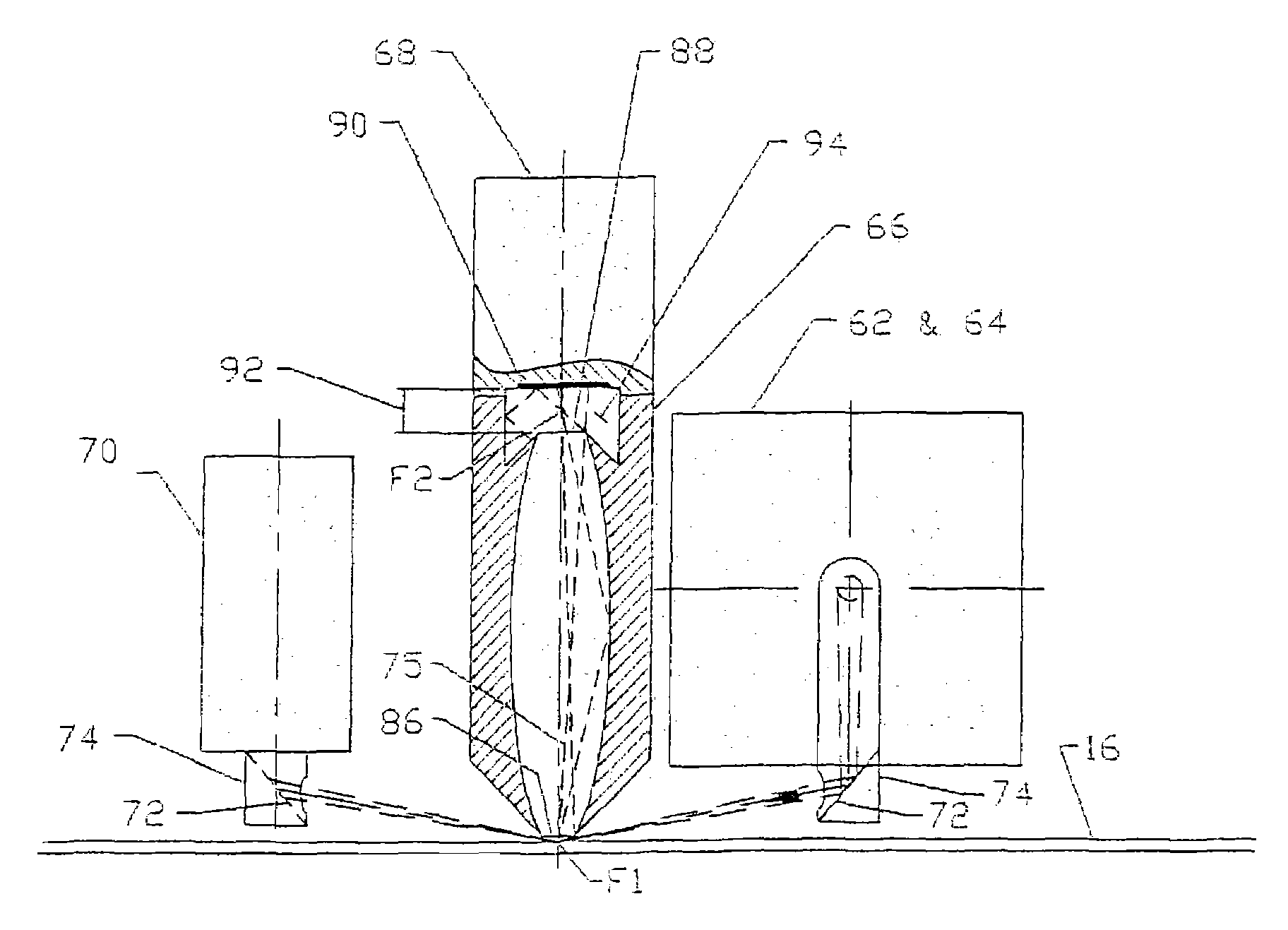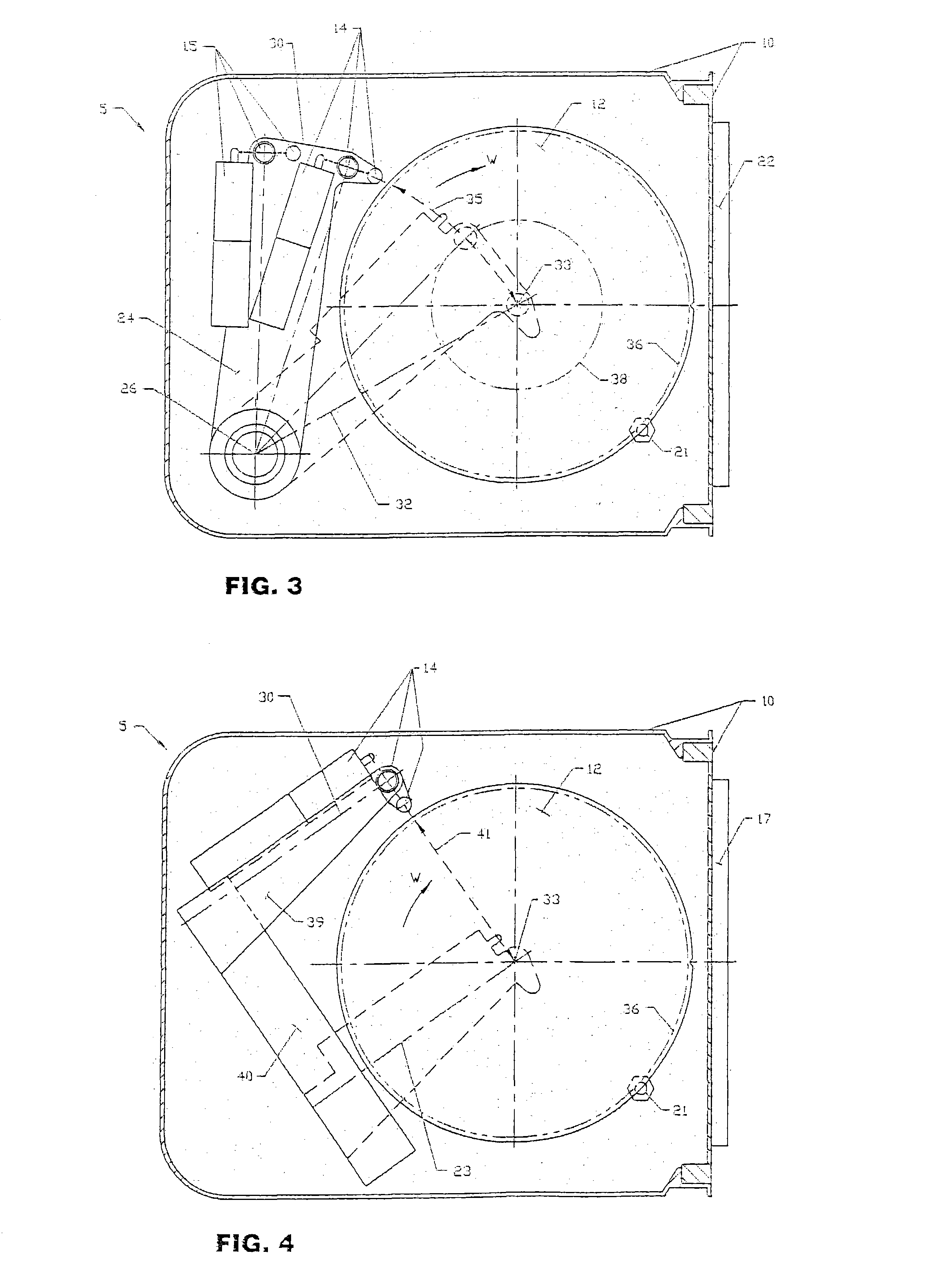Method and apparatus for locating/sizing contaminants on a polished planar surface of a dielectric or semiconductor material
a dielectric or semiconductor material, highly polished technology, applied in the direction of color/spectral properties measurement, instruments, material analysis, etc., can solve the problems of existing wafer scanning tools, time-consuming searching for sub-micron contaminants, and non-functional chips, so as to minimize the specular reflection of incident light, maximize the capture of scattered light, and the effect of high numerical apertur
- Summary
- Abstract
- Description
- Claims
- Application Information
AI Technical Summary
Benefits of technology
Problems solved by technology
Method used
Image
Examples
second embodiment
[0036]FIG. 3 illustrates scanning module 5 in which the time to scan a wafer is halved by modifying pivot arm 24 to accommodate a second instrument group 15, identical to and spaced from instrument group 14 by a distance approximately equal to half the wafer radius along arc 35. All other elements of scanning module 5 are otherwise unchanged. Instrument group 14 thus scans from a new start scan circle 38 to stop scan point 33 while instrument group 15 simultaneously scans from start scan circle 36 to a stop scan circle that is essentially the same as start scan circle 38 for instrument group 14 (in practice there is a small overlap of these start and stop scan circles). Start scan circle 38 has half the radius of start scan circle 36.
third embodiment
[0037]scanning module 5 is illustrated in FIG. 4 wherein pivoting arm 24 is replaced by a cantilever arm 39 attached to a linear stage 40 to move instrument group 14 so that its projected laser beam illuminated spot follows a linear path 41 on wafer top surface 16. All other elements of scanning module 5 are otherwise unchanged.
[0038]It follows that the dual instrument group concept of FIG. 3, used to halve the scan time, can be extrapolated to include more than two instrument groups disposed on a suitable pivot arm (ala FIG. 3) or cantilever arm (ala FIG. 4) where the scan time reduction factor is the member of instrument groups employed.
[0039]Irrespective of the scanning module 5 internal configuration the overall compact and portable system data processing electronics / computers, power supplies / distribution, vacuum source, and touch screen control / display are located outside of scanning module 5 as conceptually illustrated in FIG. 5. Therein the overall system is comprised of scan...
first embodiment
[0050]FIGS. 10A and 10B in conjunction with FIGS. 1 through 4, presents top and front views (showing component relative size proportions) of instrument group 14 positioned at a constant distance just above wafer top surface 16 and configured according to scanning module 5. Instrument group 14 is comprised of a laser 62 (in the ≦470 nm preferred wavelength range), laser beam conditioning optics 64, scattered light collector 66 (a highly elongate ellipsoidal reflector), a scattered light detector 68, and the optional reflected light beam dump / CCD camera (or other detector) 70.
[0051]The laser beam conditioning optics 64 include an electronically controlled beam shutter and produce a diffraction limited beam with a circular cross-section, a symmetrical Gaussian irradiance distribution about the optical axis, and finely focused to a circular point centered on the optical axis of the beam. The focal point on the laser beam optical axis is permanently positioned to be coincidental with the...
PUM
| Property | Measurement | Unit |
|---|---|---|
| diameter | aaaaa | aaaaa |
| diameter | aaaaa | aaaaa |
| single wavelength | aaaaa | aaaaa |
Abstract
Description
Claims
Application Information
 Login to View More
Login to View More - R&D
- Intellectual Property
- Life Sciences
- Materials
- Tech Scout
- Unparalleled Data Quality
- Higher Quality Content
- 60% Fewer Hallucinations
Browse by: Latest US Patents, China's latest patents, Technical Efficacy Thesaurus, Application Domain, Technology Topic, Popular Technical Reports.
© 2025 PatSnap. All rights reserved.Legal|Privacy policy|Modern Slavery Act Transparency Statement|Sitemap|About US| Contact US: help@patsnap.com



